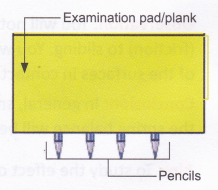Examples Of Contact Forces
Forces that act on objects by direct or indirect physical contact are called contact forces. Applied forces and friction are examples of contact forces.
Applied Forces
The forces that we use with our hands, legs, fingers, etc., are collectively called appliedforces. When we tie a stone to a string and suspend it, the tension in the string opposes the force of gravity of the Earth and keeps the stone from falling down. When we do work with our hands, like lifting a weight, or pulling an object, the force required is provided by the tension of our muscles. When we need to apply a force, the brain sends a signal to the muscle (in the form of electrical signals via the nerve cells), which makes the muscle contract. This is how we can apply a force with our hands, legs, etc.
Friction
The resistance to motion experienced when two surfaces in contact move with respect to each other is calledfriction. Whenever the surface of one body slides over that of another, each exerts a force on the other which opposes the motion of the body. This is called frictional force. Frictional force comes into play only when two surfaces are in physical contact and is, therefore, a contact force. Friction is a very complex phenomenon, and there is a lot about it that still needs to be explained. Two simple explanations for why friction is caused are as follows:
- Any surface, however smooth, has a lot of irregularities when seen under a microscope. These irregularities are like hills and valleys. When two such surfaces slide over each other, there will be a resistance to motion (friction).
- Another theory that explains friction says that when two surfaces come in contact, their atoms and molecules pull each other due to electrostatic forces. They ‘stick’ to each other at a microscopic level. When we try to slide the surfaces with respect to each other, these offer a resistance to motion. Frictional force depends on two main factors: the nature of the surfaces in contact and the mass of the object.
Activity
Aim: To show that frictional force depends on the nature of the two surfaces in contact.
Materials needed: A few books, plastic sheet, nylon cloth, gunny cloth, jute cloth, sandpaper, thread, and spring balance.
Method:
- Make a stack of books and, with the help of a thread, wrap the materials around it one by one, as shown in figure.
- Attach this stack to a spring balance, as shown in the figure, and pull gently.
- Note the reading on the spring balance.

Observation: You will notice that different materials offer different amounts of resistance (friction) to sliding. You will see from this activity that the force of friction depends on the nature of the surfaces in contact.
Conclusion: In general, smooth surfaces offer lesser friction than rough surfaces. The reading on the spring balance will be higher for rougher surfaces.
Aim: To study the effect of mass of a body on friction.
Materials needed: A 100/200 page notebook and two or three thick books (small enough so that they can be placed on the notebook).
Method:
- Place the notebook on the floor, and push the notebook gently on the floor (figure 1). Make a mental note of the resistance (friction) offered to your pushing the notebook.
- Place one thick book on the notebook and repeat step 1 (figure 2).
- Keep increasing the number of books and repeat step 1 (figure 3).

Observation: As you increase the number of books on your notebook, you will see that the frictional force increases. The area of contact and the nature of the surfaces (notebook and floor) remain the same.
Conciusion: Frictional force increases as mass increases.
Sliding and Rolling Friction
Generally, sliding an object (like a cylinder) is more difficult than rolling it. The frictional force offered when sliding an object is called sliding friction, and that offered when rolling an object is called rolling friction. The fact that rolling friction is smaller than sliding friction is made use of in a device called ball bearing.
Activity
Aim: To show that rolling friction is less than sliding friction.
Materials needed: Two wooden examination pads/planks and 4-6 pencils of equal size and round sides (or 4-6 small marbles of equal size).
Method:
- Place one of the examination pads upside down on a table top. Place it at the edge of the table so that the clip juts out. Ensure that the pad is absolutely flat on the table.
- Place the second examination pad (with the clip facing upward). Make sure that the two examination pads are touching each other back to back.
- Slide one pad over the other. Make a mental note of the friction offered.
- Place the pencils/marbles between the two back surfaces of the pads, and slide one pad over the other. Notice the friction offered.
- Compare the friction encountered in steps 3 and 4. What do you conclude?

Observation: You will notice that if pencils or marbles are placed between the two pad surfaces, the friction offered is much less. This is because the pencils/marbles roll as the pads slide across each other.
Conclusion: Rolling friction is less than sliding friction.